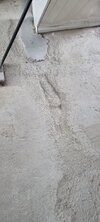Hi,
After a recent damp survey that found dry rot along a single living/dining room wall, I have taken of the plaster/mortar on the walls and removed the carpet to putdown a masonry treatment. The plan was then to paint in a liquid DPM.
I did a quick brush followed by a hoover which is when it all went a bit grim.
The hoover was pulling up the concrete as I was going along. I switched to a stiff brush but in large areas, the brush was as bad.
As a bit of an experiment I decided in a few places I'd see how deep i could get. After reaching > 1" I decided I need some help.
You can see floor leveller where the previous guys must have had the same problem as there are quite a few patches of it.
At the edge of the room, there were a few patches of leveller I took up (with some local concrete) and there appears to be a damp membrane under there. The damp guy said the floor was dry where he tested along the wet wall.
Anyway, we're having a baby soon and i need to fix this. It would be nice if I could clean it up but any attempts to brush it clean of dust just keep pulling more up - mortar and grit/aggregate. This seems to rule out patching it with any products known to man.
Any advice? we just spent a fortune on IVF. We cant really afford tradesmen but I am prepared to rip it all out if there is no other solution. This effects 40% of floor area 8.5M x 4.5M. One half of the room is 90% solid
Cheers in advance
After a recent damp survey that found dry rot along a single living/dining room wall, I have taken of the plaster/mortar on the walls and removed the carpet to putdown a masonry treatment. The plan was then to paint in a liquid DPM.
I did a quick brush followed by a hoover which is when it all went a bit grim.
The hoover was pulling up the concrete as I was going along. I switched to a stiff brush but in large areas, the brush was as bad.
As a bit of an experiment I decided in a few places I'd see how deep i could get. After reaching > 1" I decided I need some help.
You can see floor leveller where the previous guys must have had the same problem as there are quite a few patches of it.
At the edge of the room, there were a few patches of leveller I took up (with some local concrete) and there appears to be a damp membrane under there. The damp guy said the floor was dry where he tested along the wet wall.
Anyway, we're having a baby soon and i need to fix this. It would be nice if I could clean it up but any attempts to brush it clean of dust just keep pulling more up - mortar and grit/aggregate. This seems to rule out patching it with any products known to man.
Any advice? we just spent a fortune on IVF. We cant really afford tradesmen but I am prepared to rip it all out if there is no other solution. This effects 40% of floor area 8.5M x 4.5M. One half of the room is 90% solid
Cheers in advance




